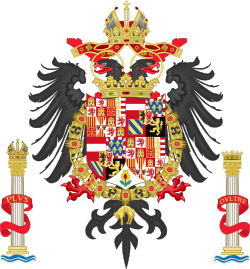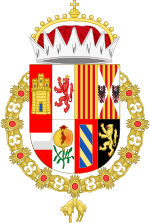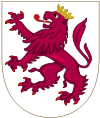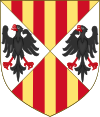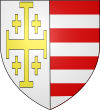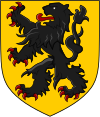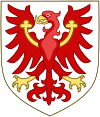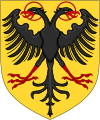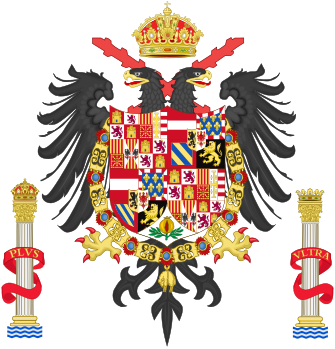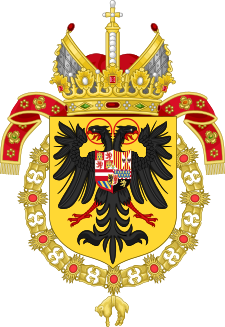
A saltire, also called Saint Andrew's Cross or the crux decussata, is a heraldic symbol in the form of a diagonal cross. The word comes from the Middle French sautoir, Medieval Latin saltatoria ("stirrup").

Duke of Fife is a title in the Peerage of the United Kingdom that has been created twice, in both cases for Alexander Duff, 1st Earl of Fife. In 1889, Lord Fife married Princess Louise, the eldest daughter of Albert Edward, Prince of Wales and a granddaughter of Queen Victoria.

In heraldry, variations of the field are any of a number of ways that a field may be covered with a pattern, rather than a flat tincture or a simple division of the field.
Ordinaries in heraldry are sometimes embellished with stripes of colour alongside them, have lumps added to them, shown with their edges arciform instead of straight, have their peaks and tops chopped off, pushed up and down out of the usual positions, or even broken apart.

In heraldry, an ordinary is one of the two main types of charges, beside the mobile charges. An ordinary is a simple geometrical figure, bounded by straight lines and running from side to side or top to bottom of the shield. There are also some geometric charges known as subordinaries, which have been given lesser status by some heraldic writers, though most have been in use as long as the traditional ordinaries. Diminutives of ordinaries and some subordinaries are charges of the same shape, though thinner. Most of the ordinaries are theoretically said to occupy one-third of the shield; but this is rarely observed in practice, except when the ordinary is the only charge.
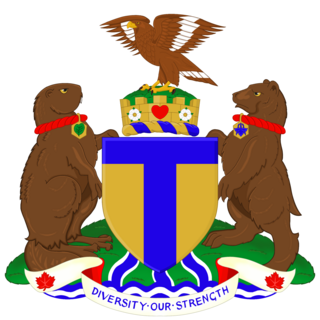
The coat of arms of Toronto is a heraldic symbol used to represent the city Toronto. Designed by Robert Watt, the Chief Herald of Canada at the time, for the City of Toronto after its amalgamation in 1998. The arms were granted by the Canadian Heraldic Authority on 11 January 1999.

The coat of arms of Sunderland is the official heraldic arms of the City of Sunderland in England.

The coat of arms of Spain represents Spain and the Spanish nation, including its national sovereignty and the country's form of government, a constitutional monarchy. It appears on the flag of Spain and it is used by the Government of Spain, the Cortes Generales, the Constitutional Court, the Supreme Court, and other state institutions. Its design consists of the arms of the medieval kingdoms that would unite to form Spain in the 15th century, the Royal Crown, the arms of the House of Bourbon, the Pillars of Hercules and the Spanish national motto: Plus Ultra. The monarch, the heir to the throne and some institutions like the Senate, the Council of State and the General Council of the Judiciary have their own variants of the coat of arms.

Edmonton was a local government district in north-east Middlesex, England, from 1850 to 1965.

The coat of arms of the King of Spain is the heraldic symbol representing the monarch of Spain. The current version of the monarch's coat of arms was adopted in 2014 but is of much older origin. The arms marshal the arms of the former monarchs of Castile, León, Aragon, and Navarre.

The blazon of the coat of arms of the Princess of Asturias is given by a Royal Decree 979 on 30 October 2015 which was an amendment of the Royal Decree 1511 dated Madrid 21 January 1977, which also created her guidon and her standard.

The coat of arms of Namibia is the official heraldic symbol of Namibia. Introduced at the time of independence in 1990, it superseded the earlier coat of arms used by the South African administration of the territory.

The Cross of Burgundy is a saw-toothed form of the Cross of Saint Andrew, the patron saint of Burgundy, and a historical banner and battle flag used by holders of the title of Duke of Burgundy and their subjects.

The Coat of arms of West Yorkshire Metropolitan County Council was granted in 1975 to the new Metropolitan county council created in the previous year. The County Council was abolished in 1986 under the provisions of the Local Government Act 1985 and consequently the arms are no longer used. The current West Yorkshire Combined Authority uses a wordmark consisting of the authorities name.

In heraldry and heraldic vexillology, a blazon is a formal description of a coat of arms, flag or similar emblem, from which the reader can reconstruct the appropriate image. The verb to blazon means to create such a description. The visual depiction of a coat of arms or flag has traditionally had considerable latitude in design, but a verbal blazon specifies the essentially distinctive elements. A coat of arms or flag is therefore primarily defined not by a picture but rather by the wording of its blazon. Blazon is also the specialized language in which a blazon is written, and, as a verb, the act of writing such a description. Blazonry is the art, craft or practice of creating a blazon. The language employed in blazonry has its own vocabulary, grammar and syntax, which becomes essential for comprehension when blazoning a complex coat of arms.
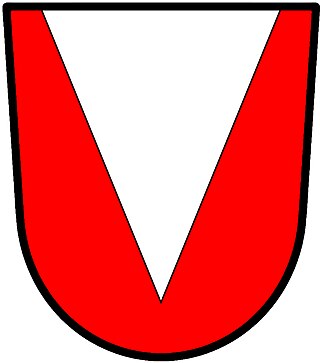
In heraldry, a pile is a charge usually counted as one of the ordinaries. It consists of a wedge emerging from the upper edge of the shield and converging to a point near the base. If it touches the base, it is blazoned throughout.
Maltese heraldry is the design, display, and study of armorial bearings as used in the traditions of Malta.
The Spanish monarchs of the House of Habsburg and Philip V used separate versions of their royal arms as sovereigns of the Kingdom of Naples-Sicily, Sardinia and the Duchy of Milan with the arms of these territories.
Coats of arms and seals of the County and Duchy of Cornwall, the Diocese of Truro, and of Cornish boroughs and towns.

The Coat of arms of the Prince of Spain was set out in the Spanish Decree 814 of 22 April 1971, by which the Rules for Flags, Standards, Guidons, Banners, and Badges were adopted.
